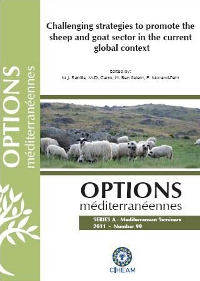| Article précédent | p. 285-291 | Article suivant |
An in vitro evaluation of the potential use of greenhouse wastes to replace barley in goats' diets
The aim of this work was to evaluate the effect of replacing barley grain with greenhouse waste fruits (tomato and cucumber) in diets for ruminants on their in vitro rumen fermentation. A control diet with cereal straw, wheat bran, sunflower meal, alfalfa hay and barley grain was compared with diets in which barley grain was gradually replaced with tomato, cucumber or a mixture (1:1) of both. These diets were incubated in batch cultures using rumen fluid from goats as inoculum. Pressure and gas volume were measured at 0, 2, 4, 6, 12, 24, 48 and 72 h post-inoculation. Samples were collected after 24 h of incubation for volatile fatty acids (VFA) analyses. The type of waste did not affect kinetic (P = 0.658 and P = 0.885 for A and c, respectively) of gas production (GP) but increasing level of waste in the diet seemed to promote faster GP rate. Waste type and level of inclusion in the diet did not change pH (P = 0.304), total VFA and most of VFA molar proportions. However, higher proportions of propionic acid (P = 0.023) were observed at the highest level of waste. Results from this experiment indicate that tomato, cucumber or a combination of both wastes can be included in ruminant diets to replace barley grain without compromising in vitro rumen fermentation.
L'effet du remplacement de l'orge par des résidus de cultures sous serre (tomate et concombre) sur la fermentation ruminale a été évalué. Un régime composé de paille de céréales (30 pour cent), blé (5 pour cent), farine de tournesol (15 pour cent), foin de luzerne (22 pour cent) et d'orge (25 pour cent) a été comparé avec d'autres ou l'orge était (0, 25, 50, 75 et 100 pour cent) remplacé par la tomate, le concombre, ou une combinaison des deux. Les régimes ont été incubés dans des cultures fermées en utilisant de liquide du rumen des chèvres comme inoculum. La pression et le volume du gaz ont été mesurés après 0, 2, 4, 6, 12, 24, 48 et 72 h. A partir de 24 h, des échantillons ont été prélevés et analysés pour les acides gras volatils (AGV). Le type de résidu n'a pas affecté (P = 0.658 et P = 0.885 pour A et c, respectivement) la production du gaz (GP). Le type de résidu et le niveau n'ont pas changé (P = 0.304) le pH, les VFA et les proportions molaires de la plupart des acides gras individuels. Les proportions les plus élevées (P = 0.023) de l'acide propionique ont été observées quand l'orge était remplacé au plus haut niveau. La tomate, le concombre ou une combinaison des deux peuvent être inclus dans l'alimentation des chèvres en remplacement de l'orge sans compromettre la fermentation ruminale.
- [ Afficher ]
- [ Télécharger ]
- [ Exporter la citation ]
Vous pouvez télécharger la citation au format :
- [ Imprimer ]
-
Mots-clés
DIGESTION DU RUMEN, GAZ, IN VITRO, ORGE, PLANTE DE SERRE, RESIDU DE RECOLTECiter cet article
Soto E.C., Yáñez Ruiz D.R., Khelil H., Molina Alcaide E. An in vitro evaluation of the potential use of greenhouse wastes to replace barley in goats' diets. In : Ranilla M.J. (ed.), Carro M.D. (ed.), Ben Salem H. (ed.), Morand-Fehr P. (ed.). Challenging strategies to promote the sheep and goat sector in the current global context. Zaragoza : CIHEAM / CSIC / Universidad de León / FAO, 2011. p. 285-291. (Options Méditerranéennes : Série A. Séminaires Méditerranéens; n. 99). 13. International Seminar of the Sub-Network on Nutrition of the FAO-CIHEAM Inter-Regional Cooperative Research and Development Network on Sheep and Goats, 2009/10/14-16, León (Spain). http://om.ciheam.org/om/pdf/a99/00801570.pdf



